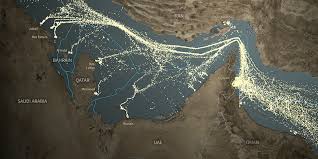Strategic Gateway of the Strait of Hormuz
Strategic Gateway of the Strait of Hormuz is not just a geographic location but a vital passage that connects the Persian Gulf to the rest of the world. Known globally as the most critical maritime chokepoint, the Strategic Gateway of the Strait of Hormuz plays a central role in transporting oil and natural gas, especially from the Middle East. Whether you’re a student learning about world geography or an adult following global trade, understanding the Strategic Gateway of the Strait of Hormuz helps you grasp how peace, security, and energy prices are deeply connected.
1. What is the Strait of Hormuz
The Strait of Hormuz is a natural sea passage — like a narrow bridge of water — that connects the Persian Gulf to the Arabian Sea.
Even though it is small in size, it is essential for transporting oil and gas from the oil-rich countries of the Middle East to the rest of the world.
2. Where Is It Located
The Strait of Hormuz lies between:
- Iran (to the north)
- Oman and the United Arab Emirates (to the south)
It is the only sea route connecting the Persian Gulf with the open ocean. Every ship leaving the Persian Gulf must pass through this strait.
3. How Big Is the Strait
- Length: About 167 kilometers
- Width: About 33 kilometers at the narrowest point
- Shipping lanes: About 2 to 3 kilometers wide in each direction
Despite being narrow, it is used by hundreds of ships daily, including the largest oil tankers in the world.
4. Why Is It So Important
- Over 20 percent of the world’s oil passes through this strait
- Also used for transporting natural gas, medicines, and consumer goods
- A blockage could lead to fuel shortages, rising prices, and economic slowdowns around the world
5. The Strait as a “Strategic Gateway”
It is called a “Strategic Gateway” because:
- It is the main route for energy exports from the Middle East
- It gives access to the global market
- Countries that depend on imported oil cannot survive economically without it
- It plays a role in international peace and defense strategies
6. Oil and Gas Trade: The Lifeline of the World
- 21 million barrels of oil pass through the Strait of Hormuz daily
- Countries like Iraq, Iran, Kuwait, Saudi Arabia, and Qatar use this route
- Qatar also sends Liquefied Natural Gas (LNG) through this strait
- The entire world’s energy security relies on this waterway staying open
7. Countries That Use the Strait
Countries that depend on oil and gas from this region include:
8. Countries That Border the Strait
- Iran – Controls the northern coast
- Oman – Controls the southern tip through the Musandam Peninsula
- United Arab Emirates (UAE) – Has ports and exports oil via this route
- Saudi Arabia, Kuwait, Iraq, Bahrain, Qatar – Export oil and gas through the Persian Gulf and Strait
9. Threats and Safety Challenges
- Geopolitical tensions (especially involving Iran and Western nations)
- Naval conflicts and military threats
- Piracy and terrorism
- Oil spills and accidents
- Even a temporary closure could lead to a global crisis
10. Environmental Value of the Region
- Rich in marine biodiversity: coral reefs, sea turtles, fish, dolphins
- Coastal zones have mangroves and wetlands
- Risk of oil pollution due to heavy shipping
- Needs strong environmental protection efforts
11. India’s Deep Connection with the Strait
- About 70 percent of India’s oil comes through this route
- Disruption affects fuel prices, economy, transport, and inflation
- India has increased naval presence in the region
- Also works with countries like the USA, Oman, and UAE for regional security
12. How the World Keeps It Safe
- International naval patrols by the USA, UK, France, India, and allies
- Military exercises and cooperation among friendly nations
- Diplomatic efforts to prevent conflict and maintain peace
- UN maritime agreements to ensure freedom of navigation
13. Conclusion: Why We All Should Care
The Strategic Gateway of the Strait of Hormuz may be narrow in width, but its global impact is massive. From shaping the price of petrol in India to influencing diplomatic ties across continents, this strategic waterway holds the world’s attention. Keeping the Strategic Gateway of the Strait of Hormuz peaceful and open is a shared responsibility — and a symbol of how one small place can hold such positive global influence.



